Introduction to Core Java feature and its characteristics
Download as PPT, PDF0 likes26 views
Introduction to Core Java
1 of 16
Download to read offline
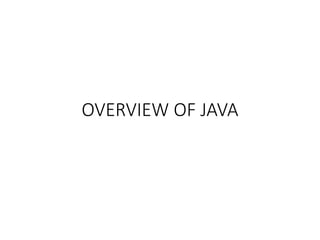
![• Java is a high-level programming language was originally
developed by Sun Microsystems, which was initiated by James
Gosling and released in 1995 as core component of Sun
Microsystems’s Java platform (Java 1.0 [J2SE]).
• Initially they called it “oak "after seeing an oak tree
But after some time, it was renamed to Java based on the name
of coffee
• With the advancement of Java and its widespread popularity,
multiple configurations were built to suite various types of
platforms.
Ex:1) J2EE for Enterprise Applications,
2)J2ME for Mobile Applications.](https://image.slidesharecdn.com/chap1-240607183047-997b86e0/85/Introduction-to-Core-Java-feature-and-its-characteristics-2-320.jpg)
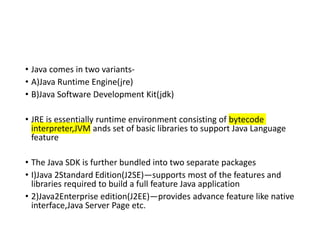

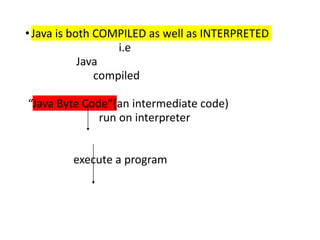
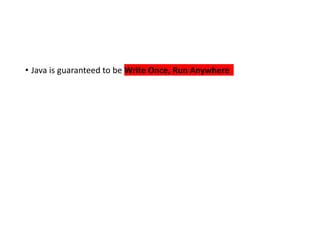
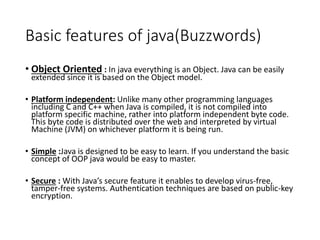
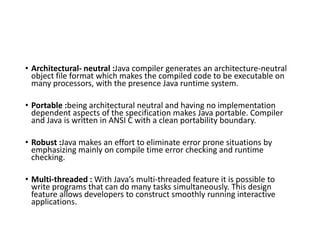
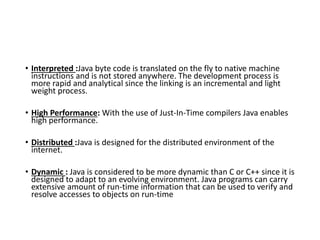

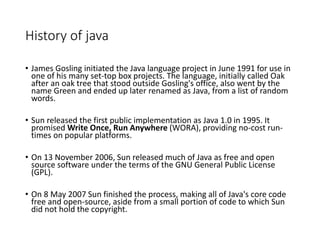
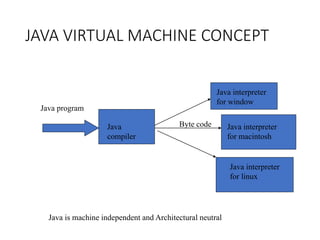
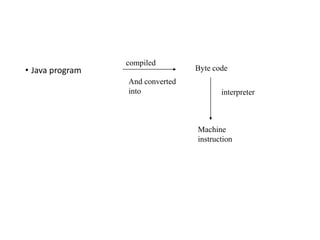
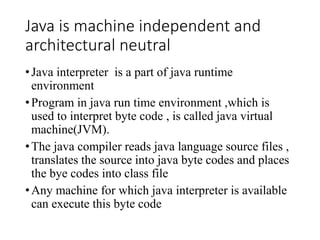
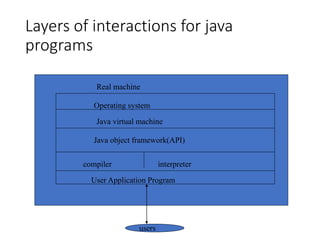

Recommended
Chapter 1 java 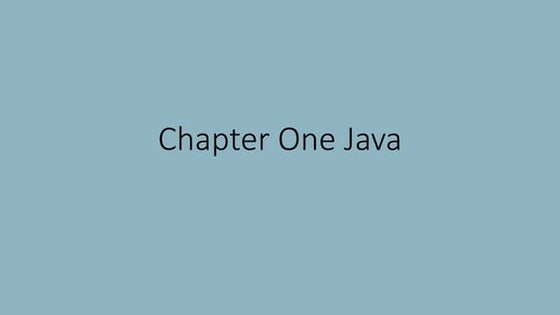



Chapter 1 java Ahmad sohail Kakar
Ěý
- Java was originally developed by Sun Microsystems in the early 1990s and was designed to be a simple, object-oriented, robust, secure, portable, high-performance, multithreaded and dynamic language.
- Key features include being platform independent via bytecode, having a robust runtime environment in the Java Virtual Machine, and being object-oriented which makes Java code reusable and extensible.
- Java tools include a JDK for development and a JRE for running programs, with the JRE containing the Java Virtual Machine to interpret bytecode and class libraries.JAVAPart1_BasicIntroduction.pptx



JAVAPart1_BasicIntroduction.pptxMurugesh33
Ěý
1. Java is a popular object-oriented programming language created by James Gosling at Sun Microsystems in 1991.
2. The Java Development Kit (JDK) provides tools for developing Java programs, and includes the Java Runtime Environment (JRE) which allows programs to run on any platform with a Java Virtual Machine (JVM).
3. Key features of Java include being platform independent, secure, robust, and multithreaded. Java code is compiled to bytecode that runs on a JVM, allowing the same code to run on different operating systems.JAVA_Day1_BasicIntroduction.pptx



JAVA_Day1_BasicIntroduction.pptxMurugesh33
Ěý
1. Java is a popular object-oriented programming language created by James Gosling at Sun Microsystems in 1991.
2. The Java Development Kit (JDK) provides tools for developing Java programs, and includes the Java Runtime Environment (JRE) which allows programs to run on various platforms.
3. The JRE contains the Java Virtual Machine (JVM) which interprets Java bytecode to execute programs consistently across different hardware and software environments.Introduction to java



Introduction to javaKrunali Gandhi
Ěý
JAVA IS A PROGRAMMING LANGUAGE.HERE IS A SHORT DESCRIPTION OF JAVA WHICH IS JUST AN INTRODUCTION PART TO IT.(KRUNALI GANDHI)Introduction to java 



Introduction to java Java Lover
Ěý
This document provides an introduction and overview of the Java programming language, including its history, features, and components. It discusses how Java was developed in 1995 at Sun Microsystems and introduced as a platform-independent language for general business applications and web-based internet applications. It also summarizes Java's key features like being object-oriented, compiled and interpreted, and portable, as well as its core architecture components like the Java programming language, Java Virtual Machine, and Java API.1 java intro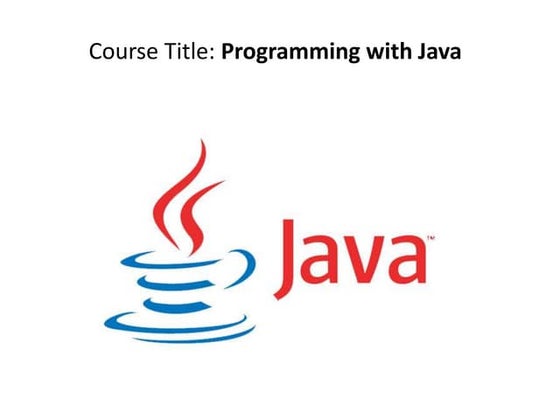



1 java introabdullah al mahamud rosi
Ěý
this slide is about java introductory.it will be helpful for you to know abc of jaba.it also be helpful for u in your versity java course.programming with java is very important for every student.java freshers can grabbed it easily1 java introduction



1 java introductionabdullah al mahamud rosi
Ěý
this slide contains about basic introduction of java.it will be helpful for a java beginner. it also useful for java lecture course in your versity.programming with java is very essential for every student.this silde may help you to progress your skill & lernt abc about java.Object Oriented Programming Part 1 of Unit 1



Object Oriented Programming Part 1 of Unit 1VigneshkumarPonnusam1
Ěý
Object Oriented Programming Part 1Java Introduction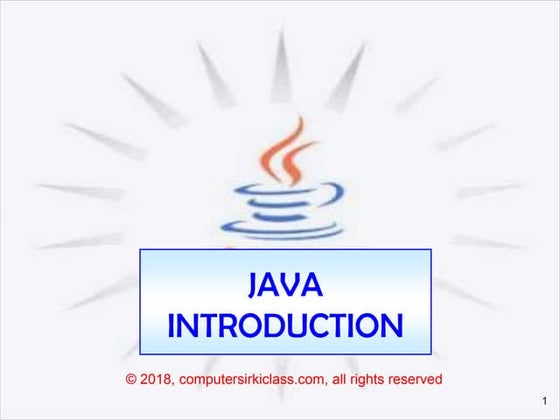



Java Introductionsunmitraeducation
Ěý
The document provides an introduction and history of Java, outlining how it was developed in the 1990s as a platform-independent language by James Gosling at Sun Microsystems, and discusses some key advantages of Java like being object-oriented, portable, robust, and having built-in support for security and multithreading. It also describes the Java Development Kit (JDK) which contains tools for developing Java programs and the Java Runtime Environment (JRE) which allows running of Java applications and includes the Java Virtual Machine.JAVA PROGRAM CONSTRUCTS OR LANGUAGE BASICS.pptx



JAVA PROGRAM CONSTRUCTS OR LANGUAGE BASICS.pptxAALIM MUHAMMED SALEGH COLLEGE OF ENGINEERING
Ěý
The document discusses various features and constructs of the Java programming language including:
- Java is an object-oriented, simple, platform-independent, secure, robust, and high-performance language.
- The Java Runtime Environment (JRE) provides the runtime platform and Java Development Kit (JDK) includes development tools.
- Java programs are compiled to bytecode that runs on the Java Virtual Machine (JVM) on any platform.
- Core Java constructs include data types, variables, operators, statements, and classes. Primitive data types include numbers, booleans, characters and strings.java basics concepts and the keywords needed



java basics concepts and the keywords neededPriyadharshiniG41
Ěý
java basics concepts and the keywords1.Intro--Why Java.pptx



1.Intro--Why Java.pptxYounasKhan542109
Ěý
This document provides an overview of the Java programming language. It discusses that Java was created in 1995 by James Gosling at Sun Microsystems, originally for television devices but was found to be better suited for internet applications. Java remains popular due to its practicality, backwards compatibility, scalability, platform independence through bytecode, and portability. The document also covers Java editions, a simple Java program example, and key concepts like classes, methods, and the main method.PPS Java Overview Unit I.ppt



PPS Java Overview Unit I.pptCDSukte
Ěý
This document provides an overview of the Java programming language and platform. It discusses Java's origins, characteristics, editions, and components like the JDK, JRE, and JVM. Java is introduced as a simple, secure, robust, and platform-independent language well-suited for client-server web applications and small devices. The document outlines Java's history and evolution from 1995 to present. Key aspects of Java like object-orientation, portability, and multi-threading are summarized.PPS Java Overview Unit I.ppt



PPS Java Overview Unit I.pptRajeshSukte1
Ěý
This document provides an overview of variables and their scope in Java. It discusses the three types of variables in Java: local variables, instance variables, and class (static) variables.
Local variables are declared within methods, constructors, or blocks and can only be accessed within their declaration scope. Instance variables are declared within a class but outside of methods and can be accessed using an object reference. Class variables are declared with the static keyword, belong to the class itself rather than any object, and are accessed via the class name. The document provides examples and discusses default variable initialization.Introduction to JAVA



Introduction to JAVAMd. Tanvir Hossain
Ěý
This document provides an introduction and overview of key features of the Java programming language. It discusses Java's origins, its object-oriented design, and how it aims to be simple, robust, secure, portable, and high-performance. Key features highlighted include automatic memory management, exception handling, threads and concurrency, generics, and its architecture neutral bytecode format which allows programs to run on any system with a Java Virtual Machine.Java (1)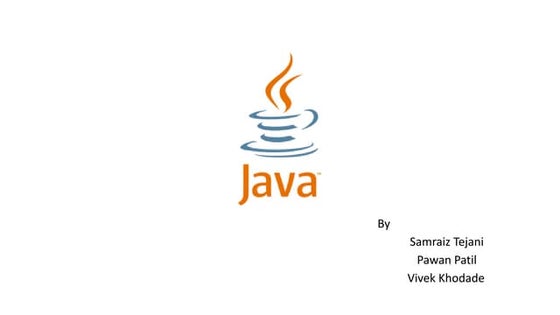



Java (1)Samraiz Tejani
Ěý
Java was created by James Gosling and his team at Sun Microsystems in 1991. It was originally designed for television but later shifted focus to use on the Internet when released in 1996. Java applications are compiled to bytecode that can run on any Java Virtual Machine, making code portable across platforms. Key features of Java include its simplicity, object-oriented design, security, and ability to write code once and run it anywhere. It differs from C/C++ in its removal of pointers and inclusion of automatic memory management through garbage collection.1. JAVA_Module_1-edited - AJIN ABRAHAM.pptx.pdf



1. JAVA_Module_1-edited - AJIN ABRAHAM.pptx.pdf10322210023
Ěý
The document provides an overview of the Java programming language. It discusses that Java was created by James Gosling at Sun Microsystems in 1995 and the latest version is Java SE 14. It then describes several key concepts and features of Java including: it being object-oriented, simple, secure, platform independent, robust, portable, dynamic, architecture neutral, high performance, multithreaded, and distributed. It also discusses the Java Virtual Machine, Java Runtime Environment, Java Development Kit, and main Java platforms.Java Basics



Java BasicsFahad Shahzad
Ěý
The document outlines the course details for a Mobile App Development class. It includes:
- The course instructor's contact information.
- Recommended reference books and websites for learning Java.
- The marking criteria for assignments, projects, exams.
- General classroom rules around cell phones, food, and behavior.
- An outline of lecture topics that will cover what Java is, its history and features.Object Oriented concept-JAVA-Module-1-PPT.pptx



Object Oriented concept-JAVA-Module-1-PPT.pptxASHWINIGOWDA46
Ěý
Java basic concepts related to engineering 3rd sem syllabus Java programming Introduction | Java basic architecture



Java programming Introduction | Java basic architectureshaswinayyan
Ěý
Introduction to the java programming languageGetting Started with JAVA



Getting Started with JAVAShivamPathak318367
Ěý
In this presentation on getting started with Java, We have discussed what is Java programming language and what are its all features.Java fundamentals



Java fundamentalsOm Ganesh
Ěý
Fundamentals background for Java Beginners . Shows the clear idea about java basic terminologies: comilation, java byte codes, jvm, jre, jdk, idebasic core java up to operator



basic core java up to operatorkamal kotecha
Ěý
This is a simple ppt it provides introduction of core java difference of c++ and java and operators used in core javaJAVA INTRODUCTION - 1



JAVA INTRODUCTION - 1Infoviaan Technologies
Ěý
Java is an object-oriented programming language that is high-level, robust, secure, portable and multi-threaded. It was developed by James Gosling at Sun Microsystems in the early 1990s. Java code is compiled into bytecode that runs on a Java Virtual Machine (JVM) making Java platform independent. The JVM interprets the bytecode and performs tasks like memory management and security.Health Promotion explained ppt.pptx



Health Promotion explained ppt.pptxMohamedIbrahim354734
Ěý
This is a seminar on health promotion, hope it will help you understanding the topicLeadership in the AI Era: The Reinvention of Human-Centered Leadership by Bor...



Leadership in the AI Era: The Reinvention of Human-Centered Leadership by Bor...Agile ME
Ěý
Artificial intelligence is not only transforming business processes but also fundamentally challenging traditional leadership concepts. In this groundbreaking keynote, leadership expert Boris Gloger explores the complex challenges and opportunities that arise for leaders in the context of AI.
Drawing on Gartner’s latest forecasts on the “Augmented Executive” and recent research on AI-supported decision-making, Gloger illuminates the evolving role of leaders. He demonstrates how AI takes over repetitive management tasks, creating space for valuable human-centered leadership.
Simultaneously, Gloger warns against uncritical faith in technology. Building on his insights from Self-Organization Needs Leadership, he argues that in the AI era, human qualities such as empathy, ethical judgment, and the ability to create meaning are indispensable.
Gloger explains how agile leadership principles can synergistically interact with AI systems to create resilient, adaptive organizations. He shows how leaders can design an ecosystem where human creativity and machine efficiency reinforce each other.
Key Topics of the Keynote:
• Realigning leadership roles in AI-driven organizations
• Ethical challenges in using AI for leadership decisions
• Promoting employee engagement and continuous learning in the AI era
• Creating a corporate culture that unites innovation and responsible AI use
• Practical strategies for integrating AI tools into agile leadership approaches
Experience a profound, forward-looking keynote that combines technological understanding with decades of leadership expertise. Gain critical insights to redefine your company and leadership role for the AI era – with a balanced approach that harmoniously unites technological innovation and human-centered leadership.More Related Content
Similar to Introduction to Core Java feature and its characteristics (20)
Java Introduction



Java Introductionsunmitraeducation
Ěý
The document provides an introduction and history of Java, outlining how it was developed in the 1990s as a platform-independent language by James Gosling at Sun Microsystems, and discusses some key advantages of Java like being object-oriented, portable, robust, and having built-in support for security and multithreading. It also describes the Java Development Kit (JDK) which contains tools for developing Java programs and the Java Runtime Environment (JRE) which allows running of Java applications and includes the Java Virtual Machine.JAVA PROGRAM CONSTRUCTS OR LANGUAGE BASICS.pptx



JAVA PROGRAM CONSTRUCTS OR LANGUAGE BASICS.pptxAALIM MUHAMMED SALEGH COLLEGE OF ENGINEERING
Ěý
The document discusses various features and constructs of the Java programming language including:
- Java is an object-oriented, simple, platform-independent, secure, robust, and high-performance language.
- The Java Runtime Environment (JRE) provides the runtime platform and Java Development Kit (JDK) includes development tools.
- Java programs are compiled to bytecode that runs on the Java Virtual Machine (JVM) on any platform.
- Core Java constructs include data types, variables, operators, statements, and classes. Primitive data types include numbers, booleans, characters and strings.java basics concepts and the keywords needed



java basics concepts and the keywords neededPriyadharshiniG41
Ěý
java basics concepts and the keywords1.Intro--Why Java.pptx



1.Intro--Why Java.pptxYounasKhan542109
Ěý
This document provides an overview of the Java programming language. It discusses that Java was created in 1995 by James Gosling at Sun Microsystems, originally for television devices but was found to be better suited for internet applications. Java remains popular due to its practicality, backwards compatibility, scalability, platform independence through bytecode, and portability. The document also covers Java editions, a simple Java program example, and key concepts like classes, methods, and the main method.PPS Java Overview Unit I.ppt



PPS Java Overview Unit I.pptCDSukte
Ěý
This document provides an overview of the Java programming language and platform. It discusses Java's origins, characteristics, editions, and components like the JDK, JRE, and JVM. Java is introduced as a simple, secure, robust, and platform-independent language well-suited for client-server web applications and small devices. The document outlines Java's history and evolution from 1995 to present. Key aspects of Java like object-orientation, portability, and multi-threading are summarized.PPS Java Overview Unit I.ppt



PPS Java Overview Unit I.pptRajeshSukte1
Ěý
This document provides an overview of variables and their scope in Java. It discusses the three types of variables in Java: local variables, instance variables, and class (static) variables.
Local variables are declared within methods, constructors, or blocks and can only be accessed within their declaration scope. Instance variables are declared within a class but outside of methods and can be accessed using an object reference. Class variables are declared with the static keyword, belong to the class itself rather than any object, and are accessed via the class name. The document provides examples and discusses default variable initialization.Introduction to JAVA



Introduction to JAVAMd. Tanvir Hossain
Ěý
This document provides an introduction and overview of key features of the Java programming language. It discusses Java's origins, its object-oriented design, and how it aims to be simple, robust, secure, portable, and high-performance. Key features highlighted include automatic memory management, exception handling, threads and concurrency, generics, and its architecture neutral bytecode format which allows programs to run on any system with a Java Virtual Machine.Java (1)



Java (1)Samraiz Tejani
Ěý
Java was created by James Gosling and his team at Sun Microsystems in 1991. It was originally designed for television but later shifted focus to use on the Internet when released in 1996. Java applications are compiled to bytecode that can run on any Java Virtual Machine, making code portable across platforms. Key features of Java include its simplicity, object-oriented design, security, and ability to write code once and run it anywhere. It differs from C/C++ in its removal of pointers and inclusion of automatic memory management through garbage collection.1. JAVA_Module_1-edited - AJIN ABRAHAM.pptx.pdf



1. JAVA_Module_1-edited - AJIN ABRAHAM.pptx.pdf10322210023
Ěý
The document provides an overview of the Java programming language. It discusses that Java was created by James Gosling at Sun Microsystems in 1995 and the latest version is Java SE 14. It then describes several key concepts and features of Java including: it being object-oriented, simple, secure, platform independent, robust, portable, dynamic, architecture neutral, high performance, multithreaded, and distributed. It also discusses the Java Virtual Machine, Java Runtime Environment, Java Development Kit, and main Java platforms.Java Basics



Java BasicsFahad Shahzad
Ěý
The document outlines the course details for a Mobile App Development class. It includes:
- The course instructor's contact information.
- Recommended reference books and websites for learning Java.
- The marking criteria for assignments, projects, exams.
- General classroom rules around cell phones, food, and behavior.
- An outline of lecture topics that will cover what Java is, its history and features.Object Oriented concept-JAVA-Module-1-PPT.pptx



Object Oriented concept-JAVA-Module-1-PPT.pptxASHWINIGOWDA46
Ěý
Java basic concepts related to engineering 3rd sem syllabus Java programming Introduction | Java basic architecture



Java programming Introduction | Java basic architectureshaswinayyan
Ěý
Introduction to the java programming languageGetting Started with JAVA



Getting Started with JAVAShivamPathak318367
Ěý
In this presentation on getting started with Java, We have discussed what is Java programming language and what are its all features.Java fundamentals



Java fundamentalsOm Ganesh
Ěý
Fundamentals background for Java Beginners . Shows the clear idea about java basic terminologies: comilation, java byte codes, jvm, jre, jdk, idebasic core java up to operator



basic core java up to operatorkamal kotecha
Ěý
This is a simple ppt it provides introduction of core java difference of c++ and java and operators used in core javaJAVA INTRODUCTION - 1



JAVA INTRODUCTION - 1Infoviaan Technologies
Ěý
Java is an object-oriented programming language that is high-level, robust, secure, portable and multi-threaded. It was developed by James Gosling at Sun Microsystems in the early 1990s. Java code is compiled into bytecode that runs on a Java Virtual Machine (JVM) making Java platform independent. The JVM interprets the bytecode and performs tasks like memory management and security.Recently uploaded (20)
Health Promotion explained ppt.pptx



Health Promotion explained ppt.pptxMohamedIbrahim354734
Ěý
This is a seminar on health promotion, hope it will help you understanding the topicLeadership in the AI Era: The Reinvention of Human-Centered Leadership by Bor...



Leadership in the AI Era: The Reinvention of Human-Centered Leadership by Bor...Agile ME
Ěý
Artificial intelligence is not only transforming business processes but also fundamentally challenging traditional leadership concepts. In this groundbreaking keynote, leadership expert Boris Gloger explores the complex challenges and opportunities that arise for leaders in the context of AI.
Drawing on Gartner’s latest forecasts on the “Augmented Executive” and recent research on AI-supported decision-making, Gloger illuminates the evolving role of leaders. He demonstrates how AI takes over repetitive management tasks, creating space for valuable human-centered leadership.
Simultaneously, Gloger warns against uncritical faith in technology. Building on his insights from Self-Organization Needs Leadership, he argues that in the AI era, human qualities such as empathy, ethical judgment, and the ability to create meaning are indispensable.
Gloger explains how agile leadership principles can synergistically interact with AI systems to create resilient, adaptive organizations. He shows how leaders can design an ecosystem where human creativity and machine efficiency reinforce each other.
Key Topics of the Keynote:
• Realigning leadership roles in AI-driven organizations
• Ethical challenges in using AI for leadership decisions
• Promoting employee engagement and continuous learning in the AI era
• Creating a corporate culture that unites innovation and responsible AI use
• Practical strategies for integrating AI tools into agile leadership approaches
Experience a profound, forward-looking keynote that combines technological understanding with decades of leadership expertise. Gain critical insights to redefine your company and leadership role for the AI era – with a balanced approach that harmoniously unites technological innovation and human-centered leadership.Meet, Greet, and Explore Agentic AI with UiPath Scotland



Meet, Greet, and Explore Agentic AI with UiPath ScotlandUiPathCommunity
Ěý
After a long break, we're excited to reconnect and reignite our community. Join us for this engaging 'Meet & Greet' event, where you'll have the opportunity to connect with fellow RPA enthusiasts, industry professionals, and AI innovators.
In this introductory session, we'll delve into the fascinating world of agentic AI, exploring how AI-powered agents are revolutionizing automation by bringing intelligence, autonomy, and decision-making capabilities to RPA workflows.
đź“• What to expect:
Networking opportunities with the UiPath Community in Scotland
A clear and engaging introduction to agentic AI
Interactive Q&A session to clarify your questions and ideas
Whether you're an experienced developer, a business leader, or completely new to automation, come along to learn, share, and connect.
Let's innovate together with UiPath Community Scotland!
Speaker/Chapter Leader:
👨‍🏫Gunashekhar Kotla, UiPath MVP, AI Automation Consultant @EY
This session streamed live on April 10, 2025, 14:00 GMT.
Check out all our upcoming UiPath Community sessions at:
👉 https://community.uipath.com/events/#...
Join UiPath Community Scotland chapter:
👉 https://community.uipath.com/scotland...April Patch Tuesday



April Patch TuesdayIvanti
Ěý
Ivanti’s Patch Tuesday breakdown goes beyond patching your applications and brings you the intelligence and guidance needed to prioritize where to focus your attention first. Catch early analysis on our Ivanti blog, then join industry expert Chris Goettl for the Patch Tuesday Webinar Event. There we’ll do a deep dive into each of the bulletins and give guidance on the risks associated with the newly-identified vulnerabilities. Automating Behavior-Driven Development: Boosting Productivity with Template-D...



Automating Behavior-Driven Development: Boosting Productivity with Template-D...DOCOMO Innovations, Inc.
Ěý
https://bit.ly/4ciP3mZ
We have successfully established our development process for Drupal custom modules, including automated testing using PHPUnit, all managed through our own GitLab CI/CD pipeline. This setup mirrors the automated testing process used by Drupal.org, which was our goal to emulate.
Building on this success, we have taken the next step by learning Behavior-Driven Development (BDD) using Behat. This approach allows us to automate the execution of acceptance tests for our Cloud Orchestration modules. Our upcoming session will provide a thorough explanation of the practical application of Behat, demonstrating how to effectively use this tool to write and execute comprehensive test scenarios.
In this session, we will cover:
1. Introduction to Behavior-Driven Development (BDD):
- Understanding the principles of BDD and its advantages in the software development lifecycle.
- How BDD aligns with agile methodologies and enhances collaboration between developers, testers, and stakeholders.
2. Overview of Behat:
- Introduction to Behat as a testing framework for BDD.
- Key features of Behat and its integration with other tools and platforms.
3. Automating Acceptance Tests:
- Running Behat tests in our GitLab CI/CD pipeline.
- Techniques for ensuring that automated tests are reliable and maintainable.
- Strategies for continuous improvement and scaling the test suite.
4. Template-Based Test Scenario Reusability:
- How to create reusable test scenario templates in Behat.
- Methods for parameterizing test scenarios to enhance reusability and reduce redundancy.
- Practical examples of how to implement and manage these templates within your testing framework.
By the end of the session, attendees will have a comprehensive understanding of how to leverage Behat for BDD in their own projects, particularly within the context of Drupal and cloud orchestration. They will gain practical knowledge on writing and running automated acceptance tests, ultimately enhancing the quality and efficiency of their development processes.Presentation Session 4 -Agent Builder.pdf



Presentation Session 4 -Agent Builder.pdfMukesh Kala
Ěý
Session 4: UiPath Agent Builder and memory toolsTNBC Research Presentation and medical virology .pptx



TNBC Research Presentation and medical virology .pptxMohamedHasan816582
Ěý
TNBC Research Presentation and medical virology .pptxSAP Automation with UiPath: Top 10 Use Cases Across FI/MM/SD/Basis/PP Modules...



SAP Automation with UiPath: Top 10 Use Cases Across FI/MM/SD/Basis/PP Modules...DianaGray10
Ěý
Explore the top 10 SAP use cases across various modules in this informative webinar. This session is for SAP professionals and people who like automation. It will show you how UiPath can automate important processes in SAP modules like FI, MM, SD, Basis, PP, and more. Learn about practical applications, benefits, and how to get started with automating these use cases on your own.SaaS Product Development Best Practices



SaaS Product Development Best PracticesApptDev
Ěý
SaaS product development has transformed the software industry into a dynamic ecosystem where innovation, customer-centric design, and rapid iteration shape market success. This presentation explores best practices that empower organizations to build, launch, and scale high-performing SaaS products in today’s competitive digital arena. It begins with an examination of agile methodologies, lean startup principles, and the importance of launching a minimal viable product (MVP) to validate market demand and reduce risk. Through iterative development cycles, teams can continuously refine features based on real user feedback while maintaining flexibility to pivot when necessary.
Strategic planning is emphasized as the cornerstone of sustainable growth. The presentation details how comprehensive market research, rigorous competitor analysis, and a clear product roadmap help align cross-functional teams, from developers and designers to marketing and customer support. Integrated DevOps practices and the adoption of cloud-based architectures further enhance operational efficiency, scalability, and performance. Robust security protocols and compliance measures are also addressed to safeguard data and meet regulatory standards.
A significant portion of the guide is dedicated to leveraging data-driven decision making. Detailed metrics and analytics empower teams to assess user engagement, track product performance, and drive continuous improvements through automation in testing, integration, and deployment. The discussion delves into best practices for managing technical debt, optimizing the development lifecycle, and ensuring that every release adds measurable value. In today’s fast-paced market, the ability to adapt quickly is not optional; it is a necessity that is fostered by iterative testing, proactive customer feedback loops, and strategic risk-taking.
Moreover, this presentation outlines advanced techniques for creating intuitive user experiences (UX), ensuring seamless onboarding, and delivering ongoing customer support that builds trust and enhances loyalty. By merging strategic vision with execution excellence, these best practices offer a comprehensive framework for startups and established enterprises alike, guiding them to achieve long-term success and competitive advantage in a rapidly evolving digital landscape.
Optimized for both innovation and efficiency, this guide serves as an essential resource for product teams aiming to thrive in the SaaS industry. Whether you are refining an existing product or embarking on a new venture, the practices outlined here will help you navigate challenges, seize opportunities, and drive lasting value for your customers.MariaDB Berlin Roadshow şÝşÝߣs - 8 April 2025



MariaDB Berlin Roadshow şÝşÝߣs - 8 April 2025MariaDB plc
Ěý
With a surge of database solutions, many open-source databases in particular lack battle-tested, enterprise-grade features. Explore MariaDB for an enterprise open source database solution.
Introduction to Generative AI refers to a subset of artificial intelligence



Introduction to Generative AI refers to a subset of artificial intelligenceKongu Engineering College, Perundurai, Erode
Ěý
Generative AI refers to a subset of artificial intelligence that focuses on creating new content, such as images, text, music, and even videos, based on the data it has been trained on. Generative AI models learn patterns from large datasets and use these patterns to generate new content. Handout - Demonolithing Think Again (Devoxx GR 2025).pdf



Handout - Demonolithing Think Again (Devoxx GR 2025).pdfScott Sosna
Ěý
Your application has advanced from "legacy" to "unmaintainable"? Corporate leaders believe it's not _that_ bad and can be migrated into a new, exciting architecture? Yeah, right. Learn the types of problems you're likely to run into, and how likely you'll never complete the demonolithing your organization is banking on.Build With AI X GDG Harare Beginners .pdf



Build With AI X GDG Harare Beginners .pdfGoogle Developer Group - Harare
Ěý
This slide is from a Build with AI beginner workshop that was hosted by Google Developer Groups Harare. It takes you through a step by step approach to creating a multiple speaker podcast using Google Cloud and the Gemini API. . It also details how the Gemma models can be used to build different applications and solutions.New from BookNet Canada for 2025: BNC SalesData and BNC LibraryData



New from BookNet Canada for 2025: BNC SalesData and BNC LibraryDataBookNet Canada
Ěý
Lily Dwyer updates us on what 2024 brought for SalesData and LibraryData. Learn about new features, such as the Age Range data and Page Count data filters, improvements to our internal Admin tool, and what’s in store for 2025.
Link to video and transcript: https://bnctechforum.ca/sessions/new-from-booknet-canada-for-2025-bnc-salesdata-and-bnc-librarydata/
Read more:
- https://www.booknetcanada.ca/salesdata
- https://booknetcanada.atlassian.net/wiki/spaces/UserDocs/pages/53707258/SalesData+Help+Manual
Presented by BookNet Canada on April 8, 2025 with support from the Department of Canadian Heritage.APAC Solutions Challenge Info Session.pdf



APAC Solutions Challenge Info Session.pdfGDG on Campus Monash
Ěý
GDG on Campus Monash hosted Info Session to provide details of the Solution Challenge to promote participation and hosted networking activities to help participants find their dream teamSAP Automation with UiPath: Leveraging AI for SAP Automation - Part 8 of 8



SAP Automation with UiPath: Leveraging AI for SAP Automation - Part 8 of 8DianaGray10
Ěý
Connect directly with the TSP team for live demonstrations and practical exercises on SAP GUI, Fiori, SuccessFactors, and more. You'll also receive exclusive SAP access to practice automation on your own machine. Bring your laptop if you want to do the exercises. Don’t miss this great opportunity to kickstart your SAP automation journey!How to Achieve High-Accuracy Results When Using LLMs



How to Achieve High-Accuracy Results When Using LLMsAggregage
Ěý
Ben Epstein, Stealth Founder & CTO, is here to share how he and his team engineered a system that employs reproducible test variations and enables non-LLM evaluation metrics for at-scale production guardrails. This walk-through will provide practical, battle-tested techniques you can immediately apply to your own LLM-powered SaaS solutions!Cloudflare’s Game-Changing Move The First Remote MCP Server for AI Agent Deve...



Cloudflare’s Game-Changing Move The First Remote MCP Server for AI Agent Deve...davidandersonofficia
Ěý
Discover how Cloudflare’s groundbreaking remote MCP server, launched April 7, 2025, is revolutionizing AI agent development. Paired with Durable Workflows and a free Durable Objects tier, this innovation simplifies building secure, scalable AI solutions. Learn why it matters, what you can create, and how to get started with Cloudflare’s game-changing tools.Automating Behavior-Driven Development: Boosting Productivity with Template-D...



Automating Behavior-Driven Development: Boosting Productivity with Template-D...DOCOMO Innovations, Inc.
Ěý
Introduction to Generative AI refers to a subset of artificial intelligence



Introduction to Generative AI refers to a subset of artificial intelligenceKongu Engineering College, Perundurai, Erode
Ěý
Cloudflare’s Game-Changing Move The First Remote MCP Server for AI Agent Deve...



Cloudflare’s Game-Changing Move The First Remote MCP Server for AI Agent Deve...davidandersonofficia
Ěý
Introduction to Core Java feature and its characteristics
- 2. • Java is a high-level programming language was originally developed by Sun Microsystems, which was initiated by James Gosling and released in 1995 as core component of Sun Microsystems’s Java platform (Java 1.0 [J2SE]). • Initially they called it “oak "after seeing an oak tree But after some time, it was renamed to Java based on the name of coffee • With the advancement of Java and its widespread popularity, multiple configurations were built to suite various types of platforms. Ex:1) J2EE for Enterprise Applications, 2)J2ME for Mobile Applications.
- 3. • Java comes in two variants- • A)Java Runtime Engine(jre) • B)Java Software Development Kit(jdk) • JRE is essentially runtime environment consisting of bytecode interpreter,JVM ands set of basic libraries to support Java Language feature • The Java SDK is further bundled into two separate packages • I)Java 2Standard Edition(J2SE)—supports most of the features and libraries required to build a full feature Java application • 2)Java2Enterprise edition(J2EE)—provides advance feature like native interface,Java Server Page etc.
- 4. JAVA IS • Simple similar to C/C++ • Scalable i.e easy to integrate • Object oriented i.e able to program real life complexities • Strongly typed language i.e it clearly distinguishes between the compile time errors that must be detected at compile time and those that occurs at runtime
- 5. •Java is both COMPILED as well as INTERPRETED i.e Java compiled “Java Byte Code”(an intermediate code) run on interpreter execute a program
- 6. • Java is guaranteed to be Write Once, Run Anywhere
- 7. Basic features of java(Buzzwords) • Object Oriented : In java everything is an Object. Java can be easily extended since it is based on the Object model. • Platform independent: Unlike many other programming languages including C and C++ when Java is compiled, it is not compiled into platform specific machine, rather into platform independent byte code. This byte code is distributed over the web and interpreted by virtual Machine (JVM) on whichever platform it is being run. • Simple :Java is designed to be easy to learn. If you understand the basic concept of OOP java would be easy to master. • Secure : With Java’s secure feature it enables to develop virus-free, tamper-free systems. Authentication techniques are based on public-key encryption.
- 8. • Architectural- neutral :Java compiler generates an architecture-neutral object file format which makes the compiled code to be executable on many processors, with the presence Java runtime system. • Portable :being architectural neutral and having no implementation dependent aspects of the specification makes Java portable. Compiler and Java is written in ANSI C with a clean portability boundary. • Robust :Java makes an effort to eliminate error prone situations by emphasizing mainly on compile time error checking and runtime checking. • Multi-threaded : With Java’s multi-threaded feature it is possible to write programs that can do many tasks simultaneously. This design feature allows developers to construct smoothly running interactive applications.
- 9. • Interpreted :Java byte code is translated on the fly to native machine instructions and is not stored anywhere. The development process is more rapid and analytical since the linking is an incremental and light weight process. • High Performance: With the use of Just-In-Time compilers Java enables high performance. • Distributed :Java is designed for the distributed environment of the internet. • Dynamic : Java is considered to be more dynamic than C or C++ since it is designed to adapt to an evolving environment. Java programs can carry extensive amount of run-time information that can be used to verify and resolve accesses to objects on run-time
- 10. For remembering • Basic features is •OPSSAPRMIHDD
- 11. History of java • James Gosling initiated the Java language project in June 1991 for use in one of his many set-top box projects. The language, initially called Oak after an oak tree that stood outside Gosling's office, also went by the name Green and ended up later renamed as Java, from a list of random words. • Sun released the first public implementation as Java 1.0 in 1995. It promised Write Once, Run Anywhere (WORA), providing no-cost run- times on popular platforms. • On 13 November 2006, Sun released much of Java as free and open source software under the terms of the GNU General Public License (GPL). • On 8 May 2007 Sun finished the process, making all of Java's core code free and open-source, aside from a small portion of code to which Sun did not hold the copyright.
- 12. JAVA VIRTUAL MACHINE CONCEPT Java compiler Java interpreter for window Java interpreter for macintosh Java interpreter for linux Java program Byte code Java is machine independent and Architectural neutral
- 13. • Java program compiled And converted into Byte code interpreter Machine instruction
- 14. Java is machine independent and architectural neutral •Java interpreter is a part of java runtime environment •Program in java run time environment ,which is used to interpret byte code , is called java virtual machine(JVM). •The java compiler reads java language source files , translates the source into java byte codes and places the bye codes into class file •Any machine for which java interpreter is available can execute this byte code
- 15. Layers of interactions for java programs Real machine Operating system Java virtual machine Java object framework(API) compiler interpreter User Application Program users
- 16. • The JVM includes: A)Byte Code Loader: will pick up the byte code file(.class) ->this byte code is then verified to ensure that it can execute correctly without violating any of Java’s rule or security consideration. Any byte code file failing is rejected at this point B)Java Interpreter:It translates the byte code files into executable instructions for the type of computer hardware and operating system the local computer is using • The java object framework(java API) acts as the intermediary between the users programs and the virtual machine which in turn acts as the intermediary between the operating system and the java object framework. Validated Byte code





